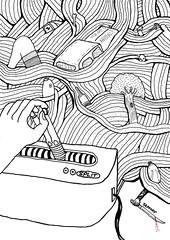 It can be a little too easy for me to perk up at pieces like Maud Newton’s, “Evolutionary (and Writerly) Advantages of Depression?” For a couple of years now, I’ve carried around in the back flap of my journal an article from the “The Lives They Lived” issue of the NY Times Magazine — year-end remembrances of those who died in the previous 12 months — on Joseph J. Schildkraut. Dr. Schildkraut died in 2006, and was one of the first in the psychiatric world to connect melancholy with creativity.
It can be a little too easy for me to perk up at pieces like Maud Newton’s, “Evolutionary (and Writerly) Advantages of Depression?” For a couple of years now, I’ve carried around in the back flap of my journal an article from the “The Lives They Lived” issue of the NY Times Magazine — year-end remembrances of those who died in the previous 12 months — on Joseph J. Schildkraut. Dr. Schildkraut died in 2006, and was one of the first in the psychiatric world to connect melancholy with creativity.
Dr. Schildkraut…mused on the grumpy, gloomy Abstract Expressionists, combining stories of their lives with views of their art to find among them “a high prevalence (about 50 percent) of depressive disorders and preoccupation with death.” By bringing (suicidal) artists like Rothko, Gorky and Pollock “into direct and lonely confrontation with the ultimate existential question, whether to live or to die,” he wrote, “depression may have put them in touch with the inexplicable mystery at the very heart of the tragic and timeless art that they aspired to produce.”
The second article I carry is a book review of Joan Acocella’s essay collection, Twenty-Eight Artists and Two Saints, in which Kathryn Harrison writes:
Acocella is interested in artistic careers that include break and recovery, and how the work changes in the wake of trauma, including the chronic, compounding trauma of rejection. She is a keen and sympathetic observer of the ways in which corrosive disappointment can strip away the veneer of culture and refinement that an immature artist typically acquires, revealing the more genuine sensitivity, the art, beneath.
Cheery stuff, indeed. (Note: in her essay, “Blocked Writers Block,” from the above collection, Acocella actually argues that writers seem to be healthier than they’ve ever been, turning more and more to exercise and coffee over alcohol and hard drugs to jolt themselves out of the blues.)
But instead of jumping into the misery-breeds-creativity discussion—it would be predictable for me to affirm my native melancholy—I want to write here about a different sort of blueness, i.e. post-partum. And I mean the good kind, where something lovely has happened, and now it’s over and you’re basking in the happy-sadness of it. This week marked the end of a 10-week fiction class I was teaching; and after the last three-hour session, as the students began to depart, a wave of sadness came over me. I found myself reaching for the students (in my mind) as they piled into the elevator while I stayed behind to gather my things; I thought, hey, wait, we were just getting started.
Of course, students come and students go, but this time around I did something a little different: instead of providing my best roster of “teachable” short stories for us to read and discuss throughout the term, I asked each of them to bring in theirs.
The absurd length of my own to-read list – the actual books that are piled on the nightstand (and the shelf, and the desk, and the floor), along with those simply collected on lists or in my mind or waiting for me at the library – often precludes me from following up on recommendations, even from people whose tastes I implicitly trust. In this case, however, I had no choice but to read what the students offered, week to week. And a very good thing, that. Here’s just a sampling of what they brought:
Philip Roth’s “The Conversion of the Jews”
Octavia Butler’s “Speech Sounds”
T. Coraghessan Boyle’s “The Hat”
Jean Thompson’s “A Winter Husband”
Junot Díaz’s “Ysrael”
Bruno Schulz’s “The Cinnamon Shops”
As for what I brought, I picked stories I’d never read before, by writers whose work I wanted to explore:
Douglas Coupland’s “Patty Hearst”
F. Scott Fitzgerald’s “Crazy Sunday”
George Saunders’s “Adams”
And at the last class, one student brought for me a parting gift (have you ever read…? he’d typed slyly on his Blackberry from the bookstore the day before. No, I typed back, something you’d recommend?): Jim Shepard’s weird and intriguing collection Like You’d Understand, Anyway.
Of all these, the Diaz story was the only one I’d read before. Each one of the others was a revelation. There’s something about straying from the traditional “best of” anthologies — the stories people love to teach (Raymond Carver, Joyce Carol Oates, Cheever, Chekhov) — and allowing students to bring what they happen to be reading, what is striking them or inspiring them (as opposed to what someone else has told them should be striking or inspiring them). The spontaneity of it, each bringing a piece of him/herself, like revealing a little secret love affair, made for a kind of grooving jazz ensemble. No wonder the sense of mourning; the thing was just beginning to boogie-woogie.
But again, these are the good blues; and as they say, it’s good to go out on a high note.
[Image credit: Tommaso Meli]








